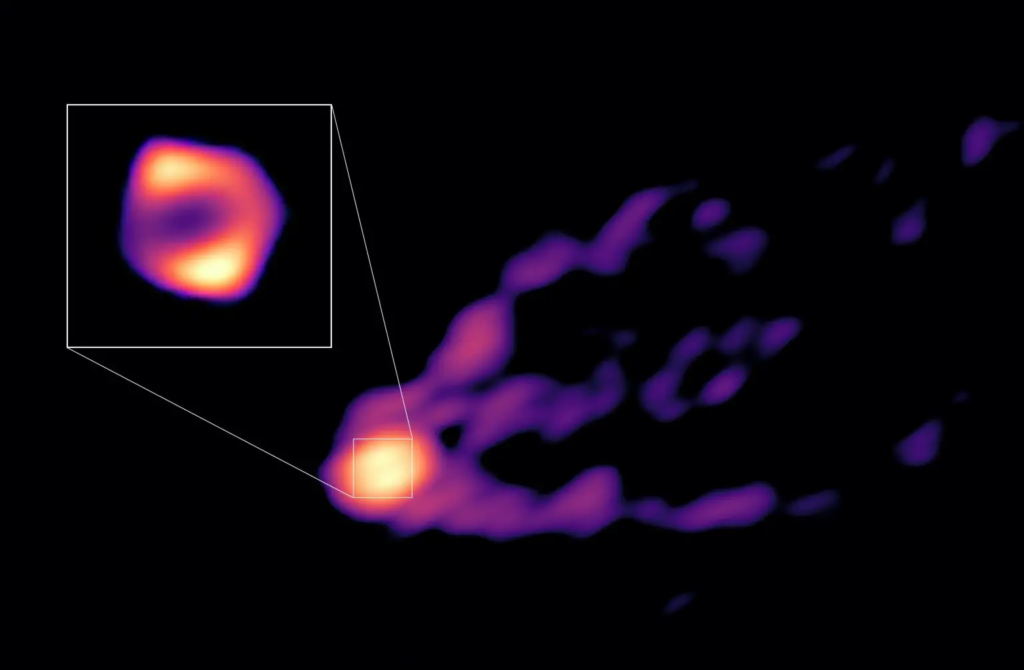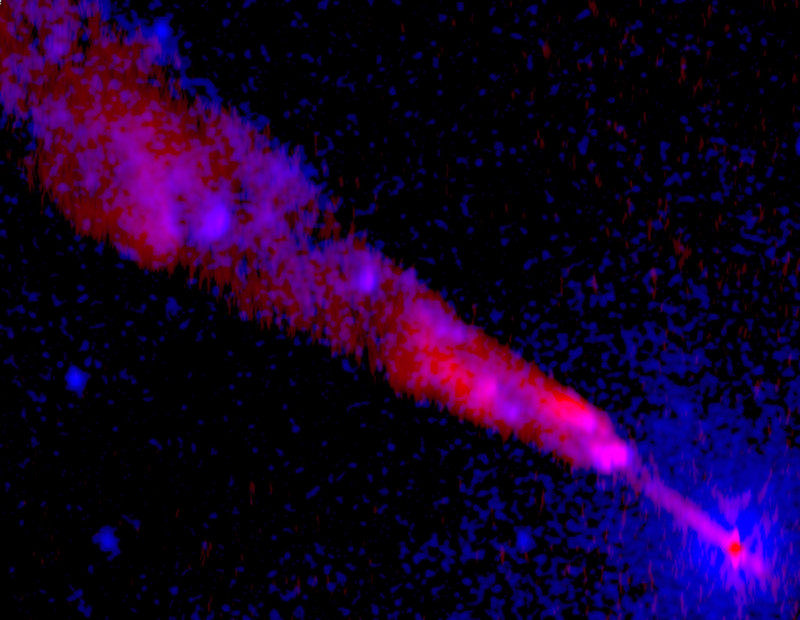An International Breakthrough in Astronomical Imaging Sheds Light on Black Hole Mysteries
The latest unveiling of a groundbreaking millimeter-wavelength picture has astounded scientists and astronomy lovers alike. This exceptional picture showcases not only the enigmatic black hole within the distinguished radio galaxy Messier 87 but in addition reveals the majestic relativistic jet accompanying it.
Captured using the Global Millimetre VLBI Array (GMVA), in collaboration with the Atacama Large Millimeter/submillimeter Array (ALMA) and the Greenland Telescope (GLT), this picture marks a pivotal moment in our understanding of black hole dynamics.
Published within the esteemed journal Nature, the findings have sparked immense excitement throughout the scientific neighborhood.
The Intertwined Dance of Matter and Energy
This pioneering picture establishes a direct connection between the matter falling into the central supermassive black hole and the origin of its accompanying jet.
Previous observations had only managed to seize separate pictures of the black hole and the jet, however the panoramic picture obtained at a brand new wavelength provides a extra comprehensive view.
Scientists have lengthy theorized that surrounding materials succumbs to a process referred to as accretion, gravitating in direction of the black hole. However, this phenomenon had never been imaged immediately.
By using a 3.5 mm observing wavelength, the picture reveals the growth and thickening of the ring-like construction, which sheds light on the extra emission produced by matter falling into the black hole. Consequently, our understanding of the intricate physical processes close to the black hole has reached new heights.

Also Read: New 62 Saturn Moons found, Totalling 145 Moons.
The Power of Collaborative Observatories
The involvement of ALMA and GLT within the GMVA observations has revolutionized our imaging capabilities, considerably augmenting the resolution and sensitivity of this intercontinental network of telescopes.
For the first time, the ring-like structure in M87 has been imaged at a wavelength of 3.5 mm, measuring a powerful 64 microarcseconds in diameter.
To put this into perspective, this diameter is akin to an astronaut on the Moon peering again at Earth through a small 5-inch (13-cm) selfie ring light.
Remarkably, this measurement surpasses earlier observations performed by the Event Horizon Telescope at 1.3 mm, aligning with expectations regarding the emission from relativistic plasma within this area.
Unveiling the Enigmatic Jet
With the combination of ALMA and GLT into GMVA observations, scientists have gained an unparalleled perspective, enabling the observation of the triple-ridged jet previously detected via VLBI observations.
This enhanced imaging capability also permits for the measurement of the ring diameter at a unique (longer) wavelength.
Thomas Krichbaum from the Max Planck Institute for Radio Astronomy (MPIfR) in Bonn confirms the importance of this discovery, stating, “We can now observe how the jet emerges from the emission ring encircling the central supermassive black hole, while also measuring the ring diameter at this alternative wavelength.”
Aalto University’s Contribution to the Breakthrough
The 14-meter radio telescope at Aalto University’s Metsähovi Radio Observatory performed a pivotal role in gathering the data required for this groundbreaking picture.
Tuomas Savolainen, a senior scientist at Aalto University and co-author of the printed paper, highlights the observatory’s long-standing involvement in GMVA measurement campaigns, extending again over a decade. Moreover, Aalto University has actively participated in VLBI observations at 3.5 mm since the mid-1990s.
Savolainen emphasizes the shortage of telescopes able to conducting measurements at 3.5 mm wavelength, making the info collected at Metsähovi all the extra valuable.
He explains that whereas the Event Horizon Telescope efficiently captured the black hole shadow in M87, the restricted variety of collaborating telescopes prevented the detection of the weaker and extra in depth jet.
Observatories geared up for 1.3 mm wavelength observations are even scarcer. Consequently, the picture obtained utilizing the GMVA, ALMA, and GLT represents a major leap ahead in our quest to unravel the mysteries of Messier 87.
Also Read: Cosmic Eureka Moment: James Webb Telescope Discovers Organic Molecule in Distant Galaxy
Illuminating the Secrets of M87
The light emanating from Messier 87 arises from the interaction between extremely energetic electrons and magnetic fields, generating synchrotron radiation.
The new picture, acquired at a wavelength of 3.5 mm, gives intricate particulars in regards to the location and vitality of those electrons, while also shedding light on the nature of the black hole itself.
Astonishingly, the black hole demonstrates a comparatively low consumption rate, converting only a fraction of the matter it captures into radiation.
Keiichi Asada of the Academia Sinica Institute of Astronomy and Astrophysics remarks on the examine’s findings, stating, “To comprehend the physical origins of the larger and thicker ring, we conducted computer simulations to explore various scenarios. Ultimately, we concluded that the increased extent of the ring is associated with the accretion flow.”
Kazuhiro Hada from the National Astronomical Observatory of Japan provides one other intriguing dimension to the analysis. Surprisingly, the info obtained reveals broader radiation from the interior area surrounding the black hole than anticipated.
This unexpected finding suggests the presence of extra than just gravitational pull, probably indicating an outward wind inflicting turbulence and chaos inside the black hole’s vicinity.

Image credit: X-ray: NASA/CXC/Bristol U./M. Hardcastle et al.; Radio: NRAO/AUI/NSF/Bristol U./M. Hardcastle
Unveiling the Universe’s Hidden Depths
While this milestone discovery offers a profound understanding of Messier 87, it represents only the beginning of an exciting journey to unravel its secrets.
The steady efforts of scientists, supported by an array of powerful telescopes, be certain that future observations will delve even deeper into the mysteries surrounding this remarkable celestial entity.
Jongho Park from the Korea Astronomy and Space Science Institute anticipates future millimeter wavelength observations, which can capture the time evolution of the M87 black hole, providing a polychromatic view with multiple color pictures in radio light.
As the spring season approaches, extra observations are already underway, and the Metsähovi Radio Observatory is actively collaborating in this next phase.
Operating on the shortest wavelength of 3.5 mm, these observations necessitate optimal weather conditions. Fortunately, April typically offers favorable climate, facilitating the acquisition of high-quality information.
Looking forward, the introduction of a new receiver for the Metsähovi telescope, able to simultaneous observations across a variety of wavelengths, will permit for improved correction of atmospheric distortions, leading to even higher-quality images.
Undoubtedly, the unveiling of the black hole and jet in Messier 87 through millimeter-wavelength observations marks an extraordinary achievement.
By pushing the boundaries of our technological capabilities, scientists have elevated our understanding of black holes and their profound affect on the cosmos. With every new revelation, we edge nearer to unraveling the enigmas that pervade the vast expanse of our universe.







